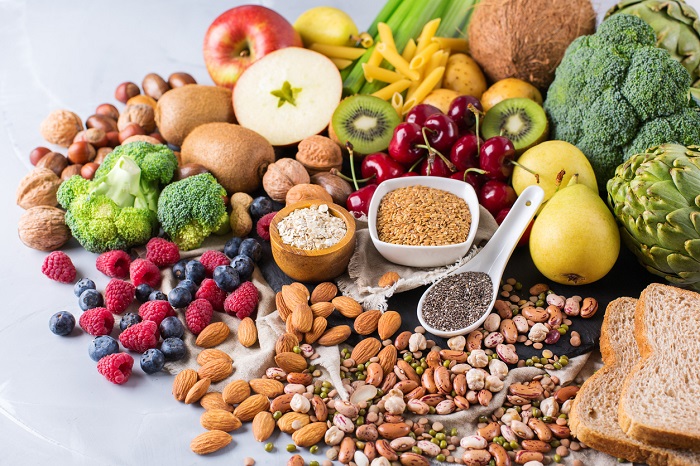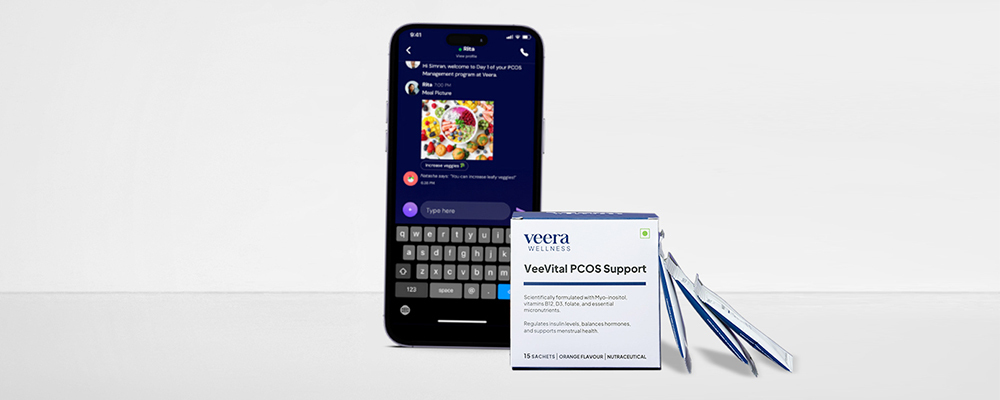PCOS has been characterized as a disorder of the endocrine system and therefore – an imbalance of hormones is responsible for it. Hormones are chemicals in our body that travel through the bloodstream and carry out multiple metabolic and physiological tasks. However, if these hormones become imbalanced – they can disrupt the normal functioning of the body. The exact cause of this imbalance or PCOS is not known and can be complex to point out. The symptoms often present themselves as a gain in weight, excessive hair or aggressive acne, and mental health issues.
How does Yoga help in Curing PCOS?
Scientists and especially doctors refer to yoga as a mind-body therapy that helps people develop strength, flexibility, and mindfulness. Depression, anxiety, and chronic inflammation are relieved when your body’s heart and breathing function are improved. Many PCOS women who have practiced yoga in some form or another have reported improvements in their overall wellbeing.
Lower levels of androgens (male hormones)
The practice of yoga mindfully has been shown to reduce the hormonal imbalance created in the body by PCOS. Through consistency and effort, you become aware of your posture and breathing during yoga. Your symptoms become controlled when your stress hormone levels are low, so your blood androgen levels are reduced.
Anti-inflammatory benefits
As you practice yoga, stress hormones are regulated in your body. In addition, you will feel relaxed physically and mentally, which is directly related to the major parts of your nervous system. Blood tests performed on women with PCOS who have practiced yoga for a specific period of time have confirmed that these hormones also reduce inflammation.
Regulating your periods
Yoga postures such as sun salutations, breathing exercises, and even meditation have been shown to greatly improve the irregular periods, excessive body hair, and mental health of women with PCOS. When coupled with a healthy diet and some physical activity, these women had lower levels of androgens and a better balance of the hormones linked directly to their periods.
Improved metabolic values
After consistently practicing yoga for a specific time period, women with PCOS have experienced stable insulin levels and cholesterol levels. Yoga has shown greater effectiveness in treating PCOS when combined with regular intense exercises.
List of Helpful Yoga Asana for PCOS Women:
Humanity and everything surrounding it has evolved, and yoga has followed suit. What’s even better is that yoga has something for everyone! Restorative yoga, for instance, can help you relax your mind and body. Alternatively, Yin yoga may strengthen your bones and ligaments if you are looking to strengthen them. It doesn’t matter what your weight, age, or gender is, yoga benefits everyone.
You are now aware that PCOS affects a number of organ systems within your body and causes a variety of symptoms. Because of this, women with PCOS have different symptoms and their severity varies too. It is important in such situations to practice yoga in a way that promotes postures that are both physically and mentally beneficial.
The following asanas are helpful for women with PCOS:
- Bridge Pose or Setu Bandha Sarvangasana
- Cobra Pose or Bhujangasana
- Sun Salutation or Surya Namaskar
- Boat Pose or Naukasana
- Breathing Exercise or Kapalbhati Pranayam
- Corpse Pose or Savasana
- Reclining Butterfly Pose or Supta Baddha Konasana
- Child Pose or Balasana
- Lotus Meditation or Padma Sadhna
Let’s take a look at these asanas briefly:
Bridge Pose or Setu Bandha Sarvangasana
This asana targets your core and helps you improve your posture (we do have bad posture from all that WFH habit of sitting in front of laptops!). Any lower back pain that you experience can be relieved with this pose. Some gentle stretching of your back, thighs, and buttocks can strengthen your core while relaxing multiple muscles.
How to do it:
- In the center of your yoga mat – lie on your back with your knees folded and your legs in a parallel position.
- Slowly, try to move your feet closer to your buttocks. Inhale steadily while pressing your feet down – thereby letting your hips do the lifting rather than your stomach.
- Get your hands together under your back and clasp them. Stretch your collarbones and firmly start lifting your lower body. You must get on your shoulders and keep a uniform pressure on your heels to lift your thighs and buttocks high and parallel.
- Once you are comfortable, exhale steadily and lower yourself to the mat. The stretching of your back will feel good and relaxing.
Cobra Pose or Bhujangasana
This asana targets your upper body and helps you stretch and relax those abdominal muscles. You will notice an improvement in your blood circulation and overall flexibility after practicing this pose.
How to do it:
- Lie face down on your yoga mat with your forehead resting on the ground.
- Keeping your legs close, place your arms parallel to your abdomen.
- Steadily, lift your head, followed by your chest and abdomen. Do not lift your body from the navel.
- Breathe in deeply and pull your torso behind – making sure that the pressure lies on your palms. Maintain this pose for a few breaths.
- Gently breathe out and bring your body back to step 1 posture.
- Repeat according to your convenience.
Sun Salutation or Surya Namaskar
This is a series of yoga postures that can help women with PCOS – manage their weight effectively.
Here is how to do it:
- At the edge of your mat, join your hands and bring them in front of your chest in a prayer position. Breathe in and breathe out deeply.
- Inhaling, lift up your arms – such that your biceps are near your ears. In this way, your entire body gets stretched.
- Exhaling, bring your hands down to the mat – bending forward waist down.
- Inhale and simultaneously slide your right leg behind as much as possible. Steadily, push your left leg behind too – much that your body is in a straight line.
- Now, you may lower your knees to the mat and exhale. Raise your buttocks a little and your body should have eight parts touching the floor – hands, feet, knees, chest, and chin.
- Sliding forward, take up the cobra pose while looking at the ceiling.
- Exhale and lift your hips – your body will look like an inverted ‘V’.
- Breathe in – bring your right foot ahead while pressing your hips down.
- Repeat steps 3-2-1 in that order.
Boat Pose or Naukasana
This asana is to strengthen your hip muscles while you master the art of balancing your body!
Here’s how to do it:
- Sit on your mat with your knees bent and feet flat.
- Slowly, lift your feet from the floor while keeping your knees bent.
- You may feel like your upper body may fall but the trick is to keep your spine steady.
- Try to straighten your legs without letting your abdomen fall back.
- When you have achieved the V shape with your legs, keep that balance for some time before releasing yourself.
- Inhale, and then you can sit up.
Breathing Exercise or Kapalbhati Pranayam
This asana ensures that your lungs work at their best capacity and improve the blood circulation in your body.
Here is how to do it:
- Sit on your mat with a straight spine. Inhale deeply.
- While you exhale, try to pull your navel towards the spine as much as you can.
- When you relax in this pose, your lungs will fill up with fresh air automatically.
- Take roughly 20 such breaths before relaxing again.
Corpse Pose or Savasana
This asana acts as a closing posture for your yoga session. It is a relaxation pose that helps you align your thoughts and feel more self-aware.
Here is how to do it:
- Lie on your back on the mat.
- One by one, release each limb from any pressure and refrain from any tension between them.
- Relax your fingers, your face, your shoulders, and everything that keeps your body tense normally.
- Breathe normally and try to focus solely on your body. This can continue for five to ten minutes for the best result.
- Slowly, start feeling your limbs again, from the extremities towards your spine.
- Stretch your arms and then contract them into a fetal position – ensuring a complete degree of rotation in your body.
Reclining Butterfly Pose or Supta Baddha Konasana
This asana is great for redirecting your blood circulation towards your essential organs. It mostly targets your torso, inner thighs, and knees – thereby improving posture to without a lot of hassle.
Here is how to do it:
- Lie on your back on the yoga mat.
- Bring your feet together and press your soles. Your knees will point outward at this point.
- With your hands above your head and your legs extended – breathe in and out deeply.
- Repeat as per your comfort.
Child Pose or Balasana
This asana is a resting pose that helps you align your thoughts and reconnect with yourself. Not only does it improve your mind-body connection, it also stretches your hips and thighs gently.
Here is how to do it:
- Sit on your knees on the mat.
- Slightly spread your knees and let your stomach touch your thighs while you bend forward. Relax your body while you do so.
- Bring your arms above your head and relax them too.
- Maintain the pose as long as you wish and then release.
Lotus Meditation or Padma Sadhna
This asana targets your hips and can help you regulate your stress immensely. This can subsequently help you level your blood pressure and prevent hypertension.
Here is how to do it:
- Be seated on the mat with your feet extended.
- Slowly, bring your right knee on your lap and cradle it with your hands. Now, bend your left knee such that you can rest on the crease on the right side of your hip.
- The soles of your foot should be facing up and your spine should be erect.
- Slow and deep inhalations can help you stay in this pose for as long as you wish.
Conclusion:
The treatment options for PCOS are often difficult to understand and implement because there is no standard of care. Currently, there is no medication that can completely cure PCOS. It has been documented that eating healthy, exercising, and even practicing yoga can reduce the symptoms and severity of this condition. Despite not being a cure for PCOS, yoga may relieve some symptoms.


















